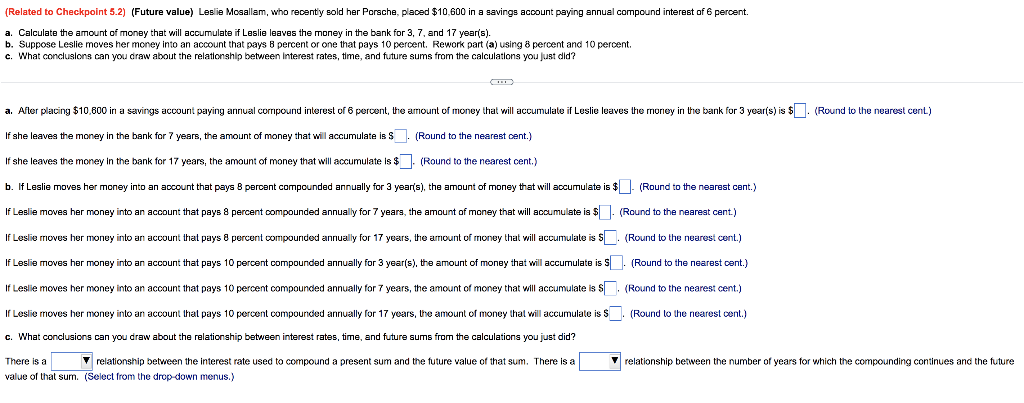
(Related to Checkpoint 5.2) (Future value) Leslie Mosallam, who recently sold her Porsche, placed $10,600 in a savings account paying annual compound interest of 6 percent. a. Calculate the amount f money that will accumulate if Leslie leaves the money in the bank for 3, 7, and 17 year(s). b. Suppose Leslie moves her money into an account that pays 8 percent or one that pays 10 percent. Rework part (a) using 8 percent and 10 percent. c. What conclusions can you draw about the relationship between interest rates, time, and future sums from the calculations you just did? a. After placing $10,800 in a savings account paying annual compound interest of 6 percent, the amount of money that will accumulate if Leslie leaves the money in the bank for 3 year(s) is $. (Round to the nearest cent) If she leaves the money in the bank for 7 years, the amount of money that will accumulate is $. (Round to the nearest cent.) If she leaves the money in the bank for 17 years, the amount of money that will accumulate is $. (Round to the nearest cent.) b. If Leslie moves her money into an account that pays 8 percent compounded annually for 3 year(s), the amount of money that will accumulate is $. (Round to the nearest cent.) If Leslie moves her money into an account that pays 8 percent compounded annually for 7 years, the amount of money that will accumulate is $. (Round to the nearest cent.) If Leslie moves her money into an account that pays 8 percent compounded annually for 17 years, the amount of money that will accumulate is $. (Round to the nearest cent.) If Leslie moves her money into an account that pays 10 percent compounded annually for 3 year(s), the amount of money that will accumulate is S. (Round to the nearest cent.) If Leslie moves her money into an account that pays 10 percent compounded annually for 7 years, the amount of money that will accumulate is $. (Round to the nearest cent.) (Round to the nearest cont.) If Leslie moves her money into an account that pays 10 percent compounded annually for 17 years, the amount of money that will accumulate is c. What conclusions can you draw about the relationship between interest rates, time, and future sums from the calculations you just did? There is a relationship between the interest rate used to compound a present sum and the future value of that sum. There is at value of that sum. (Select from the drop-down menus.) relationship between the number of years. which the compounding continues and the future







